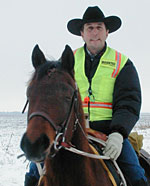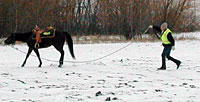Featured:

November 10, 2001 |

November 13, 2001 |

November 16, 2001 |

November 20, 2001 |
 |
 |
 |
 |
|
 |
 |
 |

Horse Quarterly |
|
 |
 |
Maybe
bigger is better. Perhaps it's the large nasal passages of
horses that allow them to detect scents up to one-quarter mile
away. Nowacki's horses know when they're on a search, and
instantly begin breathing a little heavier, trying to catch the
scent of a victim. |
Using horse
'scents'
to find the lost
Seeing is believing
by
Kate Morberg
Northern Watch Reporter
Published November 10, 2001
A new
searching source has been harnessed by an Argyle man.
For the
past 10 months Terry Nowacki has been training horses to use their
natural air scenting instinct to sniff out lost individuals. More than a
hobby, Nowacki sees the training as a beneficial tool for search and
rescue parties.
"I want
the knowledge to get out there, because I know it will save lives," said
Nowacki.
Nowacki
became interested in the air scenting technique after being involved in
a search effort using air scenting dogs in Mahnomen County. After
teaching his own dog some of the basics, Nowacki soon learned that
chasing a canine on a scent trail is quite physical.
"I
thought that maybe there's a better way to do this," he said.
This is
when he put his 20 years of horse training experience into action. For a
horse to become an efficient searcher, Nowacki said it takes around two
months. It was explained as a long, building process of praise and
reward. Training begins with a simple child's game.
"I
compare it to playing hide and seek with a three-year-old," he said.
As the
training progressed, Nowacki's horses began to detect human scent up to
one-quarter of a mile away. They are trained to find any human in their
range. This feat has been accomplished with limited training.
Stormy,
a registered quarter horse, has had 90 days of total training over the
past 10 months. There was a period of three-months in which Nowacki
worked with him only seven times, and then took one month off. Even
after the hiatus, he found the victim instantly in a test.
So far
Nowacki has trained two of his horses, and is currently working on a
third. The horses haven't had a chance to be involved in an actual
search, but continue to train, preparing themselves for the day a call
comes in.
Nowacki
is the current president of the Marshall County Minnesota Mounted
Sheriff Posse. Marshall County Sheriff Herb Maurstad sees the ability of
an air scenting horse as a real asset to search and rescue efforts.
"I'm
glad that one of the citizens of my county is taking a personal interest
in search and rescue," said Maurstad.
Maurstad said the a horse will be able to go where other animals can't.
Nowacki listed the endurance a horse has as a major advantage in using
it in searches. A horse is able to easily plow through two feet of snow,
and can cover more ground than a search dog.
Nowacki
pointed out that an air scenting horse would never take the place of a
dog. Each has areas that they are better suited for. For instance a dog
is better able for searching through thick bush, than a horse.
Test
situations are staged to check the horses' tracking ability. Successful
rescue procedures have been performed by the horses with or without a
rider. Nowacki said he doesn't give the horses any type of signals,
other than the initial "search" command, while riding them during an air
scenting mission. He prefers the horses to "think on their own."
There
are skeptics who claim he may be guiding the horse to the victim. This
myth is put to rest, as Nowacki shows how the horse can follow a scent
trail on its own without a rider.
Nowacki
said his horses know they are getting ready for a mission. A change in
the animals' behavior is noticed as the switch occurs. The horses begin
breathing a little heavier, trying to move more air through their large
olfactory passages.
Nowacki
knows of no other training like this being done with horses. The
National Association of Search and Rescue invited Nowacki to speak at
their 2001 conference. They informed Nowacki that they have never heard
of this type of training either. Nowacki said that if the air scenting
horses are being used elsewhere, NASAR would probably know about it.
"Seeing is believing," said Nowacki.
He says
friends even have a hard time believing it when they watch with their
own eyes.
The
whole situation seems daunting. Perhaps because horses, to the
inexperienced person, are rather large animals with minds of their own.
Nowacki
said the training is something the horses really seem to enjoy.
"They
forget other training because they want to forget," said Nowacki. "But
they remember this."
A horse
uses its natural air scenting ability to find traces of humans. The
scent they follow is a combination of dead skin cells, called rafts, and
body odor.
A
breeze of at least seven miles per hour creates ideal search conditions.
In an actual search, Nowacki said he would wait until the right wind
conditions to use one of his horses. This secures a more accurate
search.
"We're
at the grace of Mother Nature," said Nowacki.
Program
Manager of the Equine Industrial Management program at the University of
Minnesota, Crookston, Melissa Hower-Moritz said there is a part in a
horse's nose that helps it analyze odors. She said it's evident a horse
is smelling when it throws its head back and lifts up its lip. This is
called flehmen.
Nowacki
is a member of NASAR, and has been invited back to speak at their
conference in 2002. He is also a member of the Polk County Minnesota
Mounted Sheriff Posse.
Equine bloodhound may help find missing people
By Dan Gunderson
Minnesota Public Radio
December 19, 2001
A northern Minnesota farmer believes he's
found a new, very effective tool for search-and-rescue teams. Terry
Nowacki claims he's trained his horse to be a sort of equine bloodhound.
His work is piquing the interest of search-and-rescue experts
nationwide.
 |
 |
|
 |
| Terry Nowacki and his
horse Stormy pose in their search and rescue gear.
(MPR photo/Dan Gunderson) |
|
|
 |
| |
Nowacki and his wife Debbie farm on the
eastern edge of the Red River Valley near Argyle. His avocation is
training horses. He's also a volunteer with the Marshall county sheriffs
mounted posse search and rescue team.
Early one afternoon, Nowacki runs Stormy,
a nearly four-year-old quarter horse who's real name is El Nino Poco,
around a training ring to burn off some energy.
Like most horses, Stormy has a large and
inquisitive schnoz.
About a year-and-a-half ago, Terry helped
search for a lost person in Mahnomen county. Air-scenting dogs had to be
brought in from the Twin Cities to help because many rural counties
don't have easy access to trained search dogs.
When he came home, Nowacki thought about
training his dog, then wondered whether a horse could do the job.
"And to my surprise, the more I did the
more they liked it. I've never trained a horse for anything as easy as
they train for this," said Nowacki. "Usually it takes months. This horse
has only a total of four months training."
 |
 |
|
 |
| This is the nose that
may change the way search and rescue teams find lost
people.
(MPR photo/Dan Gunderson) |
|
|
 |
| |
Terry Nowacki estimates he has invested
about 500 hours in his pet project. He's also searched for a lot of
volunteer victims.
"For training, of course, I use strangers
as much as possible. And if it's clothing I use strangers' clothing.
People who the horses have never seen before," said Nowacki.
Many visitors to the Nowacki farm have
found themselves playing hide-and-seek with a horse.
To demonstrate Stormy's scenting ability,
Nowacki drops a shirt borrowed from a friend in a hedgerow along a farm
field. The shirt hasn't been worn for two days. Finding clothing is a
much tougher test than finding a person.
According to Nowacki, the shirt will give
off what's called a scent cone. Think of light smoke drifting with the
wind currents and you get an idea how scent moves.
"He'll go to the closest human scent,"
said Nowacki. "When he hits the scent cone, he'll let me know. He'll
take off on his own, even against my advice and he knows he won't get
reprimanded for taking the reins."
In a real search, Nowacki would ride the
horse. But just to prove he's not giving Stormy cues, he puts the horse
on a 30-foot rope.
"He'll go 30-foot circles, especially
when he thinks he caught something. He'll go and circle around and come
again. It's kind of like if you ever had anything spoil in your house
maybe under the sink. You wander around the house and sniff here and you
come back because you gotta check if you really caught that scent. He
does that too," said Nowacki.
Stormy starts across the field about 250
feet from the shirt. Midway through the first pass down the field,
Stormy catches the scent and takes a hard left toward the hedgerow.
After working up and down the hedgerow a
couple times he finds the shirt and points to it with his nose, waiting
for his handler to catch up. A handful of oats is reward for a job well
done.
 |
 |
|
 |
| Stormy homes in on the
scent of a shirt hidden in a hedgerow along this field.
His handler claims Stormy has a 90 percent success rate
in training.
(MPR photo/Dan Gunderson ) |
|
|
 |
| |
Nowacki claims Stormy has a success rate
of better than 90 percent in more than 100 training exercises. Horse and
handler are yet to be tested in a real life situation.
Marshall County Sheriff Herb Maurstad is
thrilled to have an additional tool to help search and rescue efforts.
"When the need is there, that's when you
need the resources," said Maurstad. "And you need them right now and you
don't have a lot of time. Because usually somebody's life is at stake.
And, depending on your resources, you can save a life."
The sheriff said it's exciting to be part
of a project that could affect search-and-rescue teams across the
nation.
Mike Tuttle, president of the National
Association for Search and Rescue, thinks Terry Nowacki is breaking new
ground.
"Using a horse as an air scent is really
thinking outside of the box. Something nobody's ever thought of to my
knowledge. I think it's pretty exciting and certainly worth pursuing,"
said Tuttle.
Tuttle doubts horses will replace search
dogs, but he sees several advantages. Horses can cover four or fives
times as much ground in a day, the rider has a good vantage point from
the saddle, and a horse can catch a scent wafting by several feet in the
air.
Terry Nowacki knows there are still a lot
of skeptics to convince. He thinks they'll be won over the first time
Stormy finds a lost person.
|
